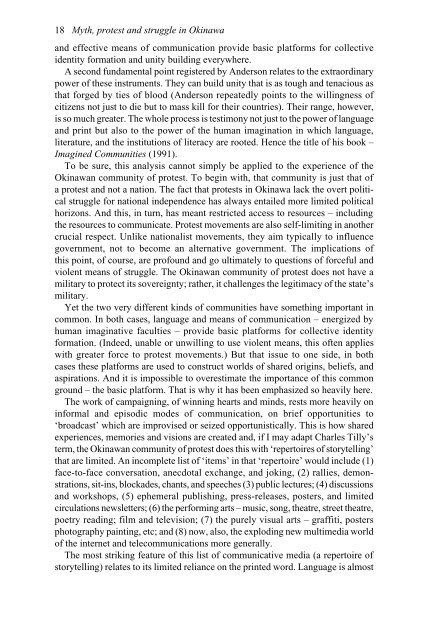Myth, Protest and Struggle in Okinawa
Myth, Protest and Struggle in Okinawa
Myth, Protest and Struggle in Okinawa
Create successful ePaper yourself
Turn your PDF publications into a flip-book with our unique Google optimized e-Paper software.
18 <strong>Myth</strong>, protest <strong>and</strong> struggle <strong>in</strong> Ok<strong>in</strong>awa<br />
<strong>and</strong> effective means of communication provide basic platforms for collective<br />
identity formation <strong>and</strong> unity build<strong>in</strong>g everywhere.<br />
A second fundamental po<strong>in</strong>t registered by Anderson relates to the extraord<strong>in</strong>ary<br />
power of these <strong>in</strong>struments. They can build unity that is as tough <strong>and</strong> tenacious as<br />
that forged by ties of blood (Anderson repeatedly po<strong>in</strong>ts to the will<strong>in</strong>gness of<br />
citizens not just to die but to mass kill for their countries). Their range, however,<br />
is so much greater. The whole process is testimony not just to the power of language<br />
<strong>and</strong> pr<strong>in</strong>t but also to the power of the human imag<strong>in</strong>ation <strong>in</strong> which language,<br />
literature, <strong>and</strong> the <strong>in</strong>stitutions of literacy are rooted. Hence the title of his book –<br />
Imag<strong>in</strong>ed Communities (1991).<br />
To be sure, this analysis cannot simply be applied to the experience of the<br />
Ok<strong>in</strong>awan community of protest. To beg<strong>in</strong> with, that community is just that of<br />
a protest <strong>and</strong> not a nation. The fact that protests <strong>in</strong> Ok<strong>in</strong>awa lack the overt political<br />
struggle for national <strong>in</strong>dependence has always entailed more limited political<br />
horizons. And this, <strong>in</strong> turn, has meant restricted access to resources – <strong>in</strong>clud<strong>in</strong>g<br />
the resources to communicate. <strong>Protest</strong> movements are also self-limit<strong>in</strong>g <strong>in</strong> another<br />
crucial respect. Unlike nationalist movements, they aim typically to <strong>in</strong>fluence<br />
government, not to become an alternative government. The implications of<br />
this po<strong>in</strong>t, of course, are profound <strong>and</strong> go ultimately to questions of forceful <strong>and</strong><br />
violent means of struggle. The Ok<strong>in</strong>awan community of protest does not have a<br />
military to protect its sovereignty; rather, it challenges the legitimacy of the state’s<br />
military.<br />
Yet the two very different k<strong>in</strong>ds of communities have someth<strong>in</strong>g important <strong>in</strong><br />
common. In both cases, language <strong>and</strong> means of communication – energized by<br />
human imag<strong>in</strong>ative faculties – provide basic platforms for collective identity<br />
formation. (Indeed, unable or unwill<strong>in</strong>g to use violent means, this often applies<br />
with greater force to protest movements.) But that issue to one side, <strong>in</strong> both<br />
cases these platforms are used to construct worlds of shared orig<strong>in</strong>s, beliefs, <strong>and</strong><br />
aspirations. And it is impossible to overestimate the importance of this common<br />
ground – the basic platform. That is why it has been emphasized so heavily here.<br />
The work of campaign<strong>in</strong>g, of w<strong>in</strong>n<strong>in</strong>g hearts <strong>and</strong> m<strong>in</strong>ds, rests more heavily on<br />
<strong>in</strong>formal <strong>and</strong> episodic modes of communication, on brief opportunities to<br />
‘broadcast’ which are improvised or seized opportunistically. This is how shared<br />
experiences, memories <strong>and</strong> visions are created <strong>and</strong>, if I may adapt Charles Tilly’s<br />
term, the Ok<strong>in</strong>awan community of protest does this with ‘repertoires of storytell<strong>in</strong>g’<br />
that are limited. An <strong>in</strong>complete list of ‘items’ <strong>in</strong> that ‘repertoire’ would <strong>in</strong>clude (1)<br />
face-to-face conversation, anecdotal exchange, <strong>and</strong> jok<strong>in</strong>g, (2) rallies, demonstrations,<br />
sit-<strong>in</strong>s, blockades, chants, <strong>and</strong> speeches (3) public lectures; (4) discussions<br />
<strong>and</strong> workshops, (5) ephemeral publish<strong>in</strong>g, press-releases, posters, <strong>and</strong> limited<br />
circulations newsletters; (6) the perform<strong>in</strong>g arts – music, song, theatre, street theatre,<br />
poetry read<strong>in</strong>g; film <strong>and</strong> television; (7) the purely visual arts – graffiti, posters<br />
photography pa<strong>in</strong>t<strong>in</strong>g, etc; <strong>and</strong> (8) now, also, the explod<strong>in</strong>g new multimedia world<br />
of the <strong>in</strong>ternet <strong>and</strong> telecommunications more generally.<br />
The most strik<strong>in</strong>g feature of this list of communicative media (a repertoire of<br />
storytell<strong>in</strong>g) relates to its limited reliance on the pr<strong>in</strong>ted word. Language is almost
















